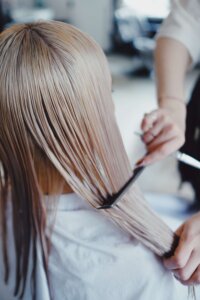Detangling 101

Beautiful, luscious locks are the epitome of healthy and well-cared-for hair. However, for many of us, detangling our hair can be a daunting and sometimes painful task. Tangles and knots are common hair concerns that can lead to breakage and damage if not addressed properly. In this Detangling 101 beauty blog, we will explore essential tips and tricks to effortlessly tame those stubborn knots and tangles, leaving your hair smooth, manageable, and beautiful.
The Importance of Detangling:
Detangling is an integral part of hair care as it not only prevents hair breakage but also maintains the overall health and appearance of your tresses. Neglecting proper detangling can lead to hair becoming more prone to knots and increased frizz, making it challenging to manage and style. Whether you have straight, wavy, curly, or coily hair, these detangling tips are suitable for all hair types.
-
Pre-Detangling Preparations:
Before diving into detangling, it’s essential to prepare your hair adequately. Begin by applying a leave-in conditioner or detangling spray to add moisture and slip to your hair. This step will help minimize friction and make the detangling process smoother. Divide your hair into sections to ensure even and thorough detangling, especially if you have thicker or longer hair.
-
Use the Right Tools:
Choosing the right detangling tools can make a world of difference in your detangling experience. Wide-tooth combs or detangling brushes with flexible bristles are excellent choices. These tools gently separate the strands, minimizing hair breakage and preventing excessive tension on your hair.
-
Detangle with Patience:
Detangling requires patience, especially if your hair is prone to knots and tangles. Start detangling from the ends of your hair and work your way up to the roots. Gradually remove tangles and knots by gently combing through the hair, using short, careful strokes. Never force your way through stubborn tangles, as this can lead to hair breakage and damage.
-
Detangle When Hair is Wet:
Detangling damp hair is often easier and less damaging than detangling dry hair. Wet hair is more flexible and has more slip, making it less likely to tangle or break. If your hair is prone to severe tangling, consider detangling in the shower while you have conditioner in your hair. Use your fingers or a wide-tooth comb to gently work through the knots.
-
Hair-Friendly Products:
Incorporate hair-friendly products into your routine to prevent future tangling and knots. Look for products that are specifically designed to reduce frizz, improve hair elasticity, and enhance manageability. Deep conditioning treatments, hair masks, and leave-in conditioners can work wonders in keeping your hair nourished and tangle-free.
-
Protective Hairstyles for Tangle Prevention:
Protective hairstyles like braids, twists, and buns can help minimize tangles and knots by keeping the hair in place and reducing friction. Additionally, sleeping on a satin or silk pillowcase can prevent tangles, as these fabrics create less friction than cotton.

Conclusion:
Detangling doesn’t have to be a daunting task. With the right techniques and a little patience, you can easily tame knots and tangles, allowing your hair to shine with health and vitality. Remember to use the right detangling tools, apply hair-friendly products, and detangle with care and patience. By incorporating these detangling tips and tricks into your hair care routine, you’ll have smooth, manageable, and beautiful tresses that are free from pesky knots and tangles. So, embrace the art of detangling, and enjoy a hassle-free hair care journey to achieve the locks you’ve always dreamed of!

